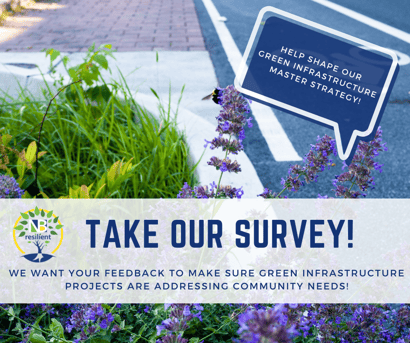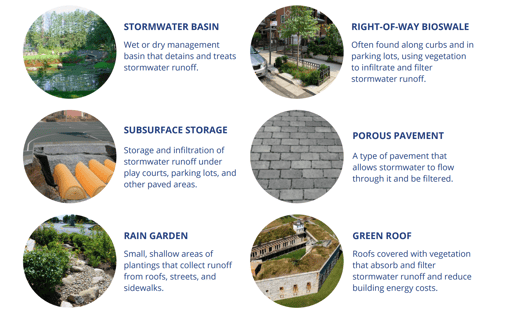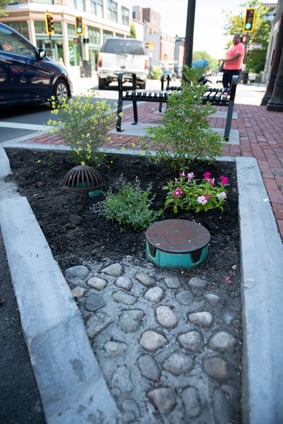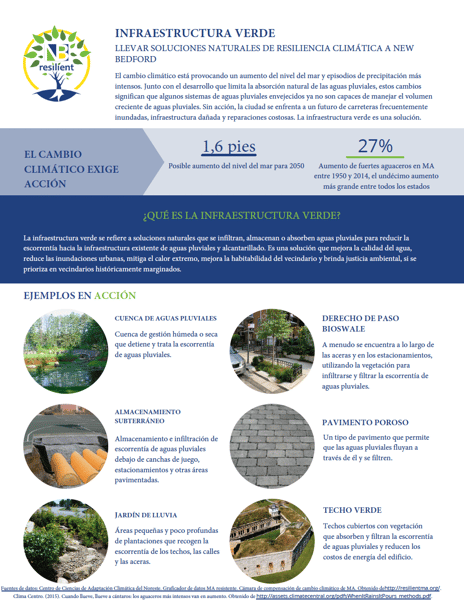
KLA clients lead the way with innovative, scalable, replicable climate solutions at the local level.
Each month in 2022 we will shine a spotlight on their bright ideas.
With flooding and extreme heat on the rise, the coastal city of New Bedford, MA, approaches stormwater management with green infrastructure and a laser focus on equitable solutions.
More intense storms and increased precipitation caused by climate change means that some aging stormwater systems are no longer capable of handling the necessary volume of stormwater. This leads to urban flooding and harmful runoff flowing into waterways. An increasingly effective and deployed answer to that problem in cities across the county is green infrastructure (GI) – which refers to a range of methods that use nature-based solutions to store or absorb stormwater to reduce flows to sewer systems or surface waters.  New Bedford, MA, recognized that it can no longer continue to build its way out of urban flooding issues and launched a Green Infrastructure Master Strategy and Implementation Roadmap that will identify priority locations for green infrastructure throughout the community and make a plan for implementing them, including training for the local workforce.
New Bedford, MA, recognized that it can no longer continue to build its way out of urban flooding issues and launched a Green Infrastructure Master Strategy and Implementation Roadmap that will identify priority locations for green infrastructure throughout the community and make a plan for implementing them, including training for the local workforce.
Nature-based solutions have been gaining steam in communities across the country. Part of what makes New Bedford’s approach unique is the emphasis on and intentional approach to *equitable* implementation of green infrastructure. Numbers and observations show that disadvantaged communities in New Bedford suffer the most from flooding and extreme heat, so that’s an integral piece of their Master Strategy.
Oh and did we mention this also helps meet the city’s climate goals?
Green Infrastructure 101
During periods of moderate rain, “grey” infrastructure—the human-engineered infrastructure for water management—is an efficient way to transport large volumes of stormwater away from developed areas. During heavy rain events – which are increasing with climate change -- the volume of stormwater may exceed the capacity of the sewer system, leading to local flooding and discharge of contaminated water into nearby waterways.  Additionally, as we convert more land to hard surfaces, like concrete or asphalt, the volume of stormwater runoff increases, because there is less vegetation to infiltrate the water. Green infrastructure is a solution that can help take the burden off the city’s grey infrastructure by reducing the amount of stormwater entering the sewer system. Solutions include natural drainage systems (bioswales), rain gardens, permeable pavement, green roofs, and tree planting.
Additionally, as we convert more land to hard surfaces, like concrete or asphalt, the volume of stormwater runoff increases, because there is less vegetation to infiltrate the water. Green infrastructure is a solution that can help take the burden off the city’s grey infrastructure by reducing the amount of stormwater entering the sewer system. Solutions include natural drainage systems (bioswales), rain gardens, permeable pavement, green roofs, and tree planting.
Co-benefits of green infrastructure include: enhanced biodiversity (native and pollinator plantings), better water quality (reduce nutrients) and air quality (tree plantings), climate mitigation and other public health benefits (reduction of vector-borne diseases) .
The basics
New Bedford’s Green Infrastructure Master Strategy and Implementation Roadmap takes a holistic look at the problem and will:
• Assess existing and proposed future drainage and combined sewer system infrastructure outlined in the City’s current plans and projects
• Identify green infrastructure opportunities
• Set priority actions for implementation, including workforce training
Any city can hire an engineer to evaluate feasibility of projects and draw up site plans, but investing in education and training, particularly for disadvantaged communities, shows commitment to equity and economic development.
With funding from the Massachusetts Municipal Vulnerability Preparedness (MVP) program, New Bedford is approaching the Green Infrastructure Master Strategy in a deliberate, equitable way to reduce the impact on disadvantaged communities that tend to be the hardest hit by urban flooding issues (due to aging infrastructure and flat topography) and extreme heat (due to lack of shade and tree canopy). This isn’t just because “equity” is a buzzword. Of New Bedford's 30 census tracts, 93% are designated Environmental Justice (EJ) communities based on the percent of minority, low income, and/or English Isolation residents.
The focus on green infrastructure is not new for New Bedford. It has been a long-time priority that was only strengthened by the NB Resilient Climate Action & Resilience Plan. Specifically, the Green Infrastructure Master Strategy will advance four priority actions from NB Resilient:
• Promote green infrastructure throughout NB parks, streets, and residential and commercial developments
• Find alternatives to non-pervious surfaces to improve stormwater flow and quality and reduce urban heat island effect
• Develop and implement an Urban Reforestation Plan to increase tree canopy coverage, reduce urban heat island and improve stormwater management
• Adopt a city-wide policy to use only native plant species, with a focus on pollinator plantings
Keys to Success
Community input Unlike traditional infrastructure like pipes buried under the ground, nature-based solutions are often more visible in the community – and even something that can be prominent on your home or business property. That makes community awareness and buy-in critical for long-term success.
Unlike traditional infrastructure like pipes buried under the ground, nature-based solutions are often more visible in the community – and even something that can be prominent on your home or business property. That makes community awareness and buy-in critical for long-term success.
During development of the Master Strategy, the City has conducted extensive community outreach to both collect input regarding priorities and concerns and to educate residents about the benefits of green infrastructure. The latter has included messaging to promote individual and community ownership of neighborhood green infrastructure installations to lay the groundwork for ongoing maintenance and support.
The City has done this through an online survey and presentations at neighborhood association and community meetings. Educational materials like a website and fact sheets (available in English, Spanish and Portuguese) and distributed to the general public, via community organizations and New Bedford Public Schools.
Workforce Development
The City is developing a training/education program for GI maintenance and operation, with three staff members who can provide GI training to city park and roadway maintenance workers. As demand for GI work skills grows within the landscaping industry, the City is incorporating GI training into its EPA grant-funded Environmental Job Training Program focused on unemployed residents in EJ communities. The City is also planning to provide training to community volunteer groups to build capacity for citizen-led stewardship of public and private spaces..jpg?width=235&name=IMG_1216%20(1).jpg) Partnerships
Partnerships
While the broader community will benefit from green infrastructure, the Master Strategy is very specific in its focus on disadvantaged communities. That makes partnerships absolutely critical to reach those communities with the right messages delivered by the right messengers at the right time.
New Bedford is working with Groundwork SouthCoast to train a youth-led “Green Team” to design and install green infrastructure and conduct outreach in the EJ neighborhoods. The City has contracted with GWSC to ensure team members receive stipends. Even goats have gotten into the action, as “goatscaping” was used to clear weeds from City property after which the Green Team worked to grade and seed the area for a native pollinator garden. .jpg?width=316&name=Goatscaping2%20(1).jpg)
What’s Next/On the Horizon
The City is in various stages of planning and implementing several GI projects throughout the community. New Bedford’s EJ communities were hit especially hard by COVID, and the City will be dedicating ARPA funds to implement projects in priority EJ areas identified in the GI Master Strategy.
February 2022: San Antonio Employee Climate Training Program
March 2022: Concord, MA, Heat Pump Coaches
April 2022: Encinitas, CA, Building Electrification Ordinance



